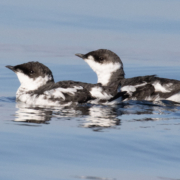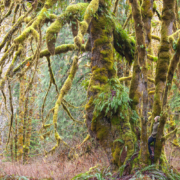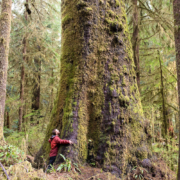Marbled Murrelets
For almost two hundred years, the Marbled Murrelet was one of North America’s most mysterious birds. Though western scientists first described this charming little seabird (likened to a “plump robin”) in 1790, no one was able to find the bird’s nest until 1974! Scientists put people on the moon before they finally tracked down the nest of this secretive bird.
How did the murrelet elude researchers for so long?
Unlike other seabirds who nest in dense colonies on islands or sea cliffs, the Marbled Murrelet nests deep in the old-growth rainforest, hiding its nest high in the mossy branches of ancient trees like towering Douglas-fir, Sitka spruce, or western redcedar. The tree needs to be big enough, with enormous branches, in order for it to acquire enough epiphytic moss to provide a deep cushion for its egg. Like weathered sailors, Marbled Murrelets spend most of their time at sea, only coming onto land when it’s time to lay their single egg. They can travel a distance of up to 80 km inland from their ocean home, looking for the perfect tree.
Since these birds only approach their nests after nightfall, for decades, scientists were unable to detect them when they left their ocean foraging grounds. Finally, the case was solved in 1974 when a tree trimmer climbing an old-growth Douglas-fir found himself staring into the eyes of a baby Marbled Murrelet, some 148 feet (45 metres) above the ground! Though the mystery of where the Marbled Murrelet nested was finally cracked, the more significant issue of saving them from extinction still needs to be solved. For every old-growth tree that falls, we lose another piece of critical nesting habitat for these endangered birds.
Due to old-growth logging across their range, Marbled Murrelet numbers have been declining since the mid-19th century. In Canada, they have been considered threatened since 2003 and are classified as globally endangered by the International Union for the Conservation of Nature and Natural Resources.
If you’re lucky enough to be camping out in an old-growth forest before sunrise, you may hear the high-pitched “keer” of these little birds as they leave their nests heading out to sea.
To learn more about the Marbled Murrelet and its future in BC, read this article from Focus on Victoria.





